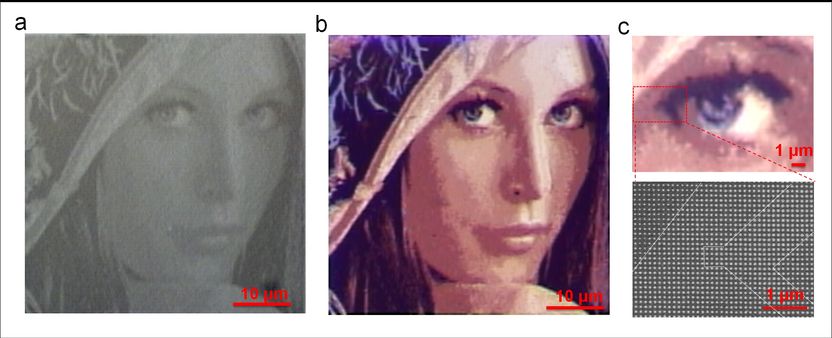Playmate with 100,000 dpi resolution
First full colour images at 100,000 dpi resolution
Advertisement
Researchers from A*STAR’s Institute of Materials Research and Engineering (IMRE) have developed an innovative method for creating sharp, full-spectrum colour images at 100,000 dots per inch (dpi), using metal-laced nanometer-sized structures, without the need for inks or dyes. In comparison, current industrial printers such as inkjet and laserjet printers can only achieve up to 10,000 dpi while research grade methods are able to dispense dyes for only single colour images. This novel breakthrough allows colouring to be treated not as an inking matter but as a lithographic matter, which can potentially revolutionise the way images are printed and be further developed for use in high-resolution reflective colour displays as well as high density optical data storage.

A coloured nanoscale rendition of a standard test image used in image processing experiments - (a) Before the addition of metal in the nanostructures, the image has only grayscale tones as observed under an optical microscope. (b) Colours are observed using the same optical microscope after addition of the metal layers to the nanostrucutres and in specific patterns. (c) Zooming into the image with the same setup, the specular reflection at the corner of the eye is observed showing the refined colour detail that the new method is able to achieve. The region indicated (bottom right) is made up of nanostructures as observed in the electron micrograph.
The image shows a portrait, part of a playboy centerfold image of Lena Söderberg, which is commonly used in tests for digital image processing.
The inspiration for the research was derived from stained glass, which is traditionally made by mixing tiny fragments of metal into the glass. It was found that nanoparticles from these metal fragments scattered light passing through the glass to give stained glass its colours. Using a similar concept with the help of modern nanotechnology tools, the researchers precisely patterned metal nanostructures, and designed the surface to reflect the light to achieve the colour images.
"The resolution of printed colour images very much depends on the size and spacing between individual ‘nanodots’ of colour", explained Dr Karthik Kumar, one of the key researchers involved. "The closer the dots are together and because of their small size, the higher the resolution of the image. With the ability to accurately position these extremely small colour dots, we were able to demonstrate the highest theoretical print colour resolution of 100,000 dpi."
“Instead of using different dyes for different colours, we encoded colour information into the size and position of tiny metal disks. These disks then interacted with light through the phenomenon of plasmon resonances,” said Dr Joel Yang, the project leader of the research. “The team built a database of colour that corresponded to a specific nanostructure pattern, size and spacing. These nanostructures were then positioned accordingly. Similar to a child’s ‘colouring-by-numbers’ image, the sizes and positions of these nanostructures defined the ‘numbers’. But instead of sequentially colouring each area with a different ink, an ultrathin and uniform metal film was deposited across the entire image causing the ‘encoded’ colours to appear all at once, almost like magic!” added Dr Joel Yang.































































